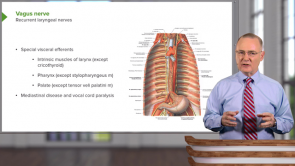Veins – Thoracic Vessels

About the Lecture
The lecture Veins – Thoracic Vessels by Craig Canby, PhD is from the course Thoracic Viscera with Dr. Canby.
Included Quiz Questions
From which intercostal spaces does the accessory hemiazygos vein receive blood?
- Left upper posterior intercostal spaces (spaces 4–8)
- Right upper posterior intercostal spaces (spaces 4–8)
- Left lower posterior intercostal spaces (spaces 9–11)
- Right lower posterior intercostal spaces (spaces 9–11)
- Right upper anterior intercostal spaces (spaces 9–11)
Which body parts are drained by the superior vena cava? Select all that apply.
- Upper limb
- Heart
- Head
- Neck
- Brain
Which statements about vessels are correct?
- The left and right brachiocephalic veins fuse to form the superior vena cava.
- The right brachiocephalic vein is longer than the left.
- The superior vena cava drains some blood from the brain.
- The diameter of both brachiocephalic veins is roughly equal.
Which statement about the anatomical relationship of the superior vena cava to its surrounding structures is correct?
- It is located on the right side of the midline.
- It is located on the left side of the midline.
- It is present on the midline.
- It is posterior to the esophagus.
- It has a tortuous course moving from one side to another.
The hemiazygos vein is formed by blood coming from which intercostal veins?
- 11, 10, and 9
- 5, 6, and 4
- 7, 8, and 5
- 5, 6, and 7
- 4, 5, and 6
Customer reviews
3,3 of 5 stars
| 5 Stars |
|
2 |
| 4 Stars |
|
0 |
| 3 Stars |
|
0 |
| 2 Stars |
|
1 |
| 1 Star |
|
1 |
Everything is explained very clearly. I understood all the information in the video perfectly.
Great lecture--very clear and easy to follow. This can be tricky, and Dr. Canby made it very easy to follow
extremely poor presentation. no disrespect to the professor but his anatomy lectures are so far the worst in lecturio!
I chose this rating because the structures the Lecturer is describing are unclear and difficult to follow. If the instructure had better visualization--such as highlighting the veins as he spoke--that would help immensley. An additional thing that would have helped is to have a visual summary of which veins feed into which at the end of the segment so the students could organize the vein tributaries better in their minds. I like the over all information, it just needs to be presented better.


![Anatomy [Archive]](https://assets-cdn1.lecturio.de/lecture_collection/image_medium/87992_1693919964.png)

